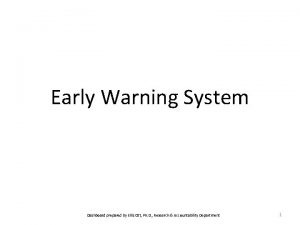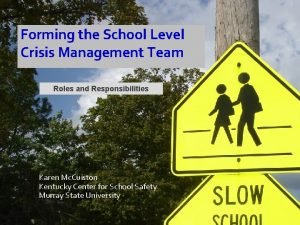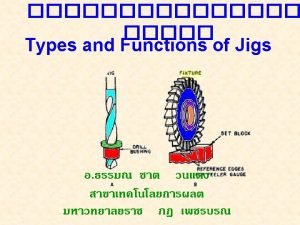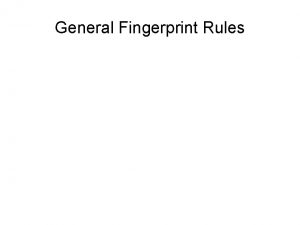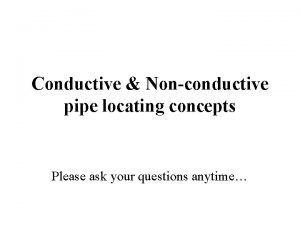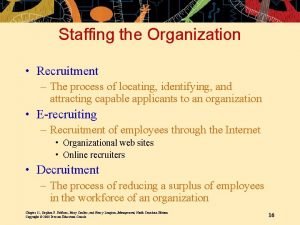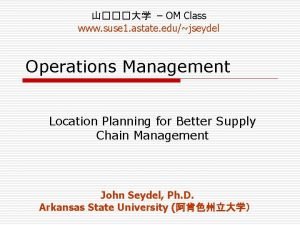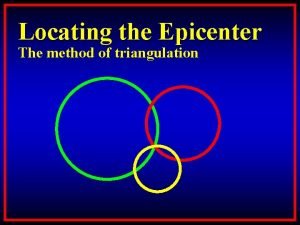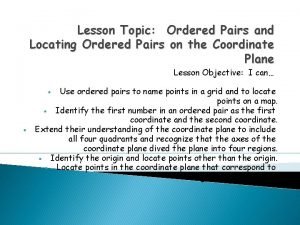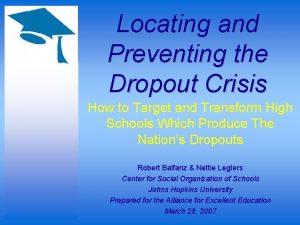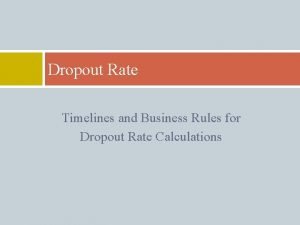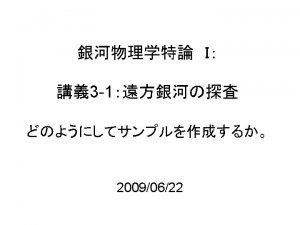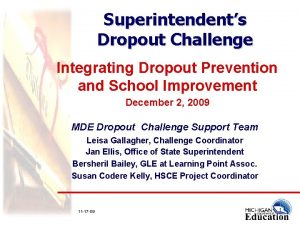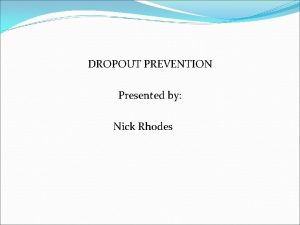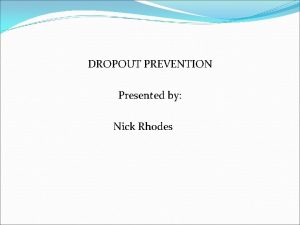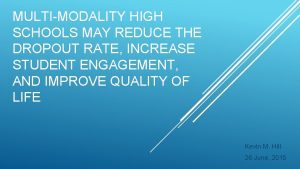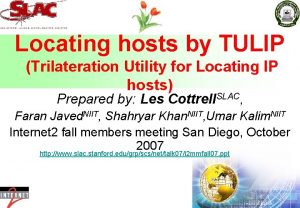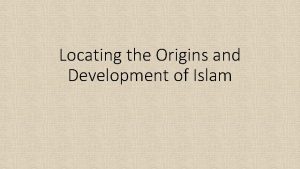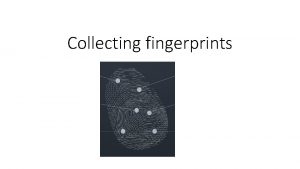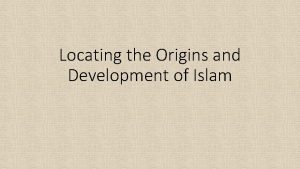Locating the Dropout Crisis Which High Schools Produce








































- Slides: 40

Locating the Dropout Crisis Which High Schools Produce the Nation’s Dropouts? Where Are They Located? Who Attends Them? Robert Balfanz and Nettie Legters Center for Social Organization of Schools Johns Hopkins University June 2004

Background v CRESPAR v Talent Development High Schools v Markers of Low Performing High Schools v Poor prior preparation v Poor attendance, high mobility v Large, impersonal organization v Massive course failure v Low promotion, high dropout, and low graduation rates

Where Did All The Freshmen Go? 12 th Graders 11 th Graders 10 th Graders 9 th Graders 197 259 327 484 Number of 9 th Graders in 1996/97 = 669 % Fewer 12 th graders in 1999/2000 than 9 th graders 1996/97 = 71%

Promoting Power Twelfth grade enrollment Yr X Ninth grade enrollment Yr X-4 v Is it a perfect estimate of dropout/graduation rates? v Is it a good first order indicator of a low performing high school, easily calculable and using readily available data? v Does it address NCLB guidelines? v Harvard Civil Rights Project Forums 2001, 2003

How Many High Schools Have Weak Promoting Power? v 900 -1, 000 High Schools have Promoting Power of 50% or less v About 2, 000 High Schools have Promoting Power of 60% or less

v The Number of High Schools with Weak Promoting Power Grew During the 1990’s


v The Gap Between HS’s with Weak Promoting Power and the National Norm is a striking 40 to 60 Percentage Points


v Who Attends High Schools that Produce the Nation’s Dropouts?

High Schools with Weak Promoting Power are Overwhelmingly Majority Minority v A Majority Minority HS is Five Times More Likely to have Weak Promoting Power Than a Majority White School


v 50 Years After Brown vs Board of Ed, 46% of African American, 39% of Latino, and 11% of White Students Attend High Schools with Weak Promoting Power (60% or less)


Not All Majority Minority HS’s Have Weak Promoting Power. Two Notable Exceptions Are: v Selective Admission High Schools in Large Cities v Majority Minority HS’s in Affluent Suburbs




v Where Are High Schools with Weak Promoting Power Located?

High Schools with Weak Promoting Power Are Located in a Sub-set of the Nation’s Cities and States v 80% of the High Schools that have the lowest levels of promoting power (50% or less) and produce the highest numbers of dropouts are located in just 15 states Louisiana Arizona North Carolina California Florida Georgia Illinois Michigan Mississippi New Mexico New York Ohio Pennsylvania South Carolina Texas

v 43% of the High Schools with the lowest levels of promoting power are located in Just 34 Cities



v In Some Cities Students Have Virtually No Other Choice but to Attend a High School with Weak Promoting Power





v. There Are Some Notable Regional Differences

v. In Northern Industrial States Weak Promoting Power Schools Are Almost Exclusively Attended by Minority Students and Located in Large and Medium Size Cities


v. In the South, Weak Promoting Power High Schools Can be Found in High Numbers Throughout the States



Policy Implications Good News v Manageable number of schools and we can locate the bulk of the work v Converging discourse on what needs to be done v Increasing level of know how v Leadership and support

Policy Implications Bad News Transforming low performing high schools and systems is not easy, fast, or cheap

Not Easy v Need comprehensive and systemic approach to avoid isolated efforts that exacerbate inequity v Consider multiple approaches as appropriate to context v Develop and scale-up technical and human supports for transformation v Align federal, state, district, and school-based efforts

Not Fast “The trick is how to sustain interest in a reform that requires a generation to complete. ” Debbie Meyer NCLB & States must acknowledge reality and progress using multiple indicators

Not Cheap v Continue and expand public and private funding v Institutionalize targeted resources – Title I – Perkins

Center for Social Organization of Schools, Johns Hopkins University www. csos. jhu. edu 410 -516 -8800
 College dropout review
College dropout review Myasthenic crisis vs cholinergic crisis
Myasthenic crisis vs cholinergic crisis Dropout 線上看
Dropout 線上看 Ott dropout
Ott dropout Questionnaire on school dropouts
Questionnaire on school dropouts School crisis response team roles
School crisis response team roles Powerschool huntsville city schools login
Powerschool huntsville city schools login Safety reach target
Safety reach target Locating pins for jigs and fixtures
Locating pins for jigs and fixtures Locating places
Locating places Rules in core location
Rules in core location Inductive clamp locating method
Inductive clamp locating method Earth science regents part d
Earth science regents part d Four ways of locating the ethical in you
Four ways of locating the ethical in you Recruitment is the process of locating identifying and
Recruitment is the process of locating identifying and Champion cooling company is locating a warehouse
Champion cooling company is locating a warehouse Triangulation method epicenter
Triangulation method epicenter Smart city locating
Smart city locating Locating tetrahedral and octahedral voids
Locating tetrahedral and octahedral voids What is a directly stated main idea
What is a directly stated main idea Locating ordered pairs on the coordinate plane
Locating ordered pairs on the coordinate plane Sophisticated printer used to produce high-quality drawings
Sophisticated printer used to produce high-quality drawings What is output devices
What is output devices Among us
Among us Hình ảnh bộ gõ cơ thể búng tay
Hình ảnh bộ gõ cơ thể búng tay Lp html
Lp html Bổ thể
Bổ thể Tỉ lệ cơ thể trẻ em
Tỉ lệ cơ thể trẻ em Gấu đi như thế nào
Gấu đi như thế nào Chụp tư thế worms-breton
Chụp tư thế worms-breton Chúa yêu trần thế
Chúa yêu trần thế Các môn thể thao bắt đầu bằng tiếng chạy
Các môn thể thao bắt đầu bằng tiếng chạy Thế nào là hệ số cao nhất
Thế nào là hệ số cao nhất Các châu lục và đại dương trên thế giới
Các châu lục và đại dương trên thế giới Công thức tính thế năng
Công thức tính thế năng Trời xanh đây là của chúng ta thể thơ
Trời xanh đây là của chúng ta thể thơ Mật thư tọa độ 5x5
Mật thư tọa độ 5x5 Phép trừ bù
Phép trừ bù độ dài liên kết
độ dài liên kết Các châu lục và đại dương trên thế giới
Các châu lục và đại dương trên thế giới Thể thơ truyền thống
Thể thơ truyền thống



